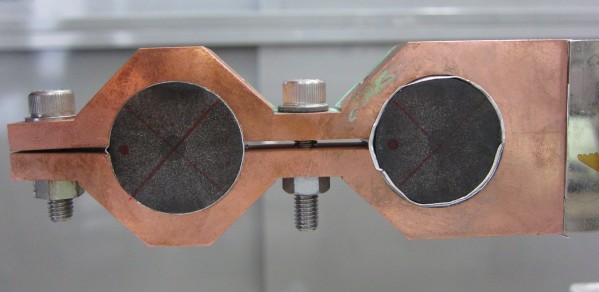
Dr Mark Ainslie of the Bulk Superconductivity Group, in conjunction with a Japanese research team, has achieved a bulk superconductor magnetic field record.
I hope our collaboration, which combines extensive experiments and simulations, is very important in this field.
Hiroyuki Fujishiro
The record-high trapped magnetic field of 1.1 T at 13 K in a magnesium diboride (MgB2) bulk superconductor using a practical, pulsed-field magnetisation technique comes on the heels of the Bulk Superconductivity Group’s previous 2014 world record result, where 17.6 T was achieved in a stack of two Gd-Ba-Cu-O high-temperature superconductors at 26 K using a slower and more expensive, field-cooling magnetisation technique. Field-cooling is commonly used for fundamental, high-field measurements and gives the best indication of the maximum trapped field capability of a sample.
The research was carried out in collaboration with Professor Hiroyuki Fujishiro of Iwate University, Japan, and was published in the journal Superconductor Science and Technology. This is in parallel with Dr Ainslie’s recently published work on enhancing the practical trapped magnetic field achievable in bulk high-temperature superconductors using a novel magnetising technique based on a split-coil arrangement with a soft iron yoke to improve the effectiveness of the system.
Pulsed-field magnetisation, which involves the application of a large, pulsed magnetic field with a timescale on the order of milliseconds, shows the most promise to magnetise bulk superconductors for high-magnetic field applications as it allows for a fast, compact and relatively inexpensive magnetising technique. However, one significant challenge with this technique is that the trapped field is generally smaller than the theoretical maximum of the material due to the temperature rise from the rapid dynamic movement of magnetic flux in and out of the material. This can lead to thermomagnetic instabilities that manifest themselves as flux jumps, which are particularly prevalent at low temperatures and for large applied magnetic fields.
 Dr Mark Ainslie
Dr Mark Ainslie
The researchers were able to overcome issues relating to these flux jumps, which had frequently occurred in the MgB2 bulk when using a conventional solenoid coil magnetising technique.
Although the 1.1 T result has set a new record, there is still some work to do to improve pulsed-field magnetisation as MgB2 bulk materials are capable of trapping magnetic fields in excess of 5 T at temperatures below 20 K using the slower and more expensive magnetising technique that is commonly used for fundamental measurements on bulk materials.
Professor Fujishiro said of the result: “The idea of the use of the split coil for bulk superconductors came about from my previous experimental experience and the theoretical analysis of the trapped field and the effect of the soft iron yoke came from Dr Ainslie’s extensive experience with numerical simulations. I hope our collaboration, which combines extensive experiments and simulations, is very important in this field. We want to enhance practical trapped fields for MgB2 and Gd-Ba-Cu-O bulks even further, and at the same time, we want to propose new pulsed-field techniques to enhance the trapped field and extend these techniques to practical applications.”
According to the paper’s authors, the work has important implications for practical applications of bulk superconductors:
Although the critical temperature, Tc, for MgB2 is relatively low (39 K), requiring a lower operating temperature (15-20 K), the material is cheaper, lighter weight and has more homogeneous superconducting properties, and shows great promise as a trapped field magnet as an alternative to high-temperature bulk superconductors.
Such a split-coil arrangement with an iron yoke could be incorporated into the design of a portable, high magnetic field source/magnet to enhance the available magnetic field or in an axial gap-type bulk superconducting electric machine, where iron can be incorporated into the stator windings to (1) improve the trapped field from the magnetization process, and (2) increase the effective air-gap magnetic field.
The research was funded by Dr Ainslie’s Royal Academy of Engineering Research Fellowship, a Royal Society International Exchanges Scheme grant, and a Grant-in-Aid for Scientific Research from the Ministry of Education, Culture, Sports, Science and Technology in Japan.
The fruitful collaboration began in 2013 after Dr Ainslie spent six weeks on a research visit to various labs in Japan, funded by the Royal Academy of Engineering and an Institution of Engineering and Technology Travel Award. This included two weeks with Professor Fujishiro that has resulted in eight publications to date, seven of which were published in the field’s leading superconductivity journal, Superconductor Science and Technology.
Two of these were selected as Superconductor Science and Technology's “Highlights of 2015,” including Dr Ainslie and Professor Fujishiro’s topical review paper on modelling of bulk superconductor magnetization that has been downloaded more than 3,100 times since March 2015 and has led to a contract with the IOP eBooks programme to be completed by December 2017.
Trapped field of 1.1 T without flux jumps in an MgB2 bulk during pulsed field magnetization using a split coil with a soft iron yoke: http://dx.doi.org/10.1088/0953-2048/29/8/084001

